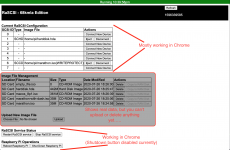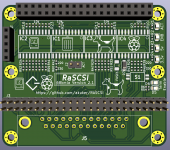landoGriffin
Well-known member
So..... I did a bunch of stuff today....
[*]Lots of work on the web control interface. It kind-of works now! You can add drives, remove them, restart the RaSCSI process, etc. (I disabled the shutdown button temporarily.... I didn't want to accidentally shut down the pi, then have to walk downstairs to turn it back on )
)
Unfortunately, I didn't test with Netscape until later in the evening. Currently, everything works in Chrome, but none of the Javascript will run in Netscape 4. So, that needs to be worked.
Another thing I learned today... (Besides that Netscape is a pain in the rear).... Netscape doesn't seem to use the font-family information in PHP files. I was able to change the fonts in .html files. But just by renaming the file to .php, Netscape ignores all of the font tags. *Sigh*
If anyone has some time, I would really appreciate another set of eyes on the schematic, to make sure that I copied Gimons' "Full Spec" schematic correctly.
https://github.com/akuker/RASCSI/blob/master/hw/rascsi_2p1/rascsi_2p1_sch.pdf
http://retropc.net/gimons/rascsi/fullspec.png
- Last week I ordered a bunch of 74LS245 tranceivers ($0.65 each) to see if they would be a workable alternative to the 74LS641 ($3 each) in the original RaSCSI design. Today I got around to trying them out. So far, they're working great. There are some differences in the data sheets that probably need some more analyzing. But, the 74LS245 seems to be working!
- I created a RaSCSI "2.1" board. Changes from the current one include:
Changed a lot of the parts to smaller SMD parts. Even though it results in more parts, JLCPCB's assembly for SMD parts is crazy cheap.
- Updated to be a "FULL SPEC" version of the board. This will allow it to be an "initiator" in the SCSI chain. I'm thinking it will also work better for capturing SCSI traffic from existing devices (such as Zip drives, etc).
- Shrunk the physical board so that it isn't bigger than a Pi Model B.
- Added header to control the activity LED
- I *think* with these updates and switching to the 74LS245, the cost of the board should be ~$15-20! (Depending upon shipping costs)
[*]Lots of work on the web control interface. It kind-of works now! You can add drives, remove them, restart the RaSCSI process, etc. (I disabled the shutdown button temporarily.... I didn't want to accidentally shut down the pi, then have to walk downstairs to turn it back on

Unfortunately, I didn't test with Netscape until later in the evening. Currently, everything works in Chrome, but none of the Javascript will run in Netscape 4. So, that needs to be worked.
Another thing I learned today... (Besides that Netscape is a pain in the rear).... Netscape doesn't seem to use the font-family information in PHP files. I was able to change the fonts in .html files. But just by renaming the file to .php, Netscape ignores all of the font tags. *Sigh*
If anyone has some time, I would really appreciate another set of eyes on the schematic, to make sure that I copied Gimons' "Full Spec" schematic correctly.
https://github.com/akuker/RASCSI/blob/master/hw/rascsi_2p1/rascsi_2p1_sch.pdf
http://retropc.net/gimons/rascsi/fullspec.png





